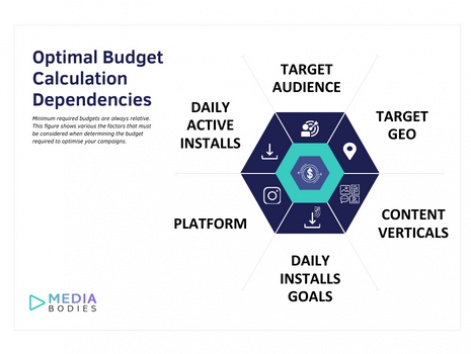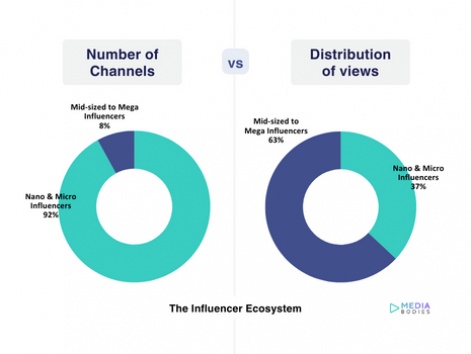Edward Fuller, CEO of Media Bodies, data-led influencer marketing experts, explains why your current campaigns may not be getting the return on investment you expect - and offers five actionable steps you can take to scale your next campaign.
Introduction: The evolving UA landscape
We're seeing an exciting wave of new gaming consumers, with the mobile gaming market alone predicted to surpass $250 billion by 2030.
However the increasingly competitive landscape means User Acquisition (UA) teams need to establish impactful strategies to accelerate competitiveness while accommodating changing consumer behaviours and legislations around commercialised messaging.
Amongst the available strategies, influencer marketing has been somewhat of a dark horse on the user acquisition front for years. Marketers recognise its theoretical value, but few can recreate this value in practice.
In the last year alone we’ve spoken to over 100 UA and marketing teams about their approach to Influencer Marketing and we've come to recognise some common refrains- “It doesn’t produce ROI,” “There’s no way to track and measure impact,” “It’s just not scalable.”
Most teams tend to chalk these challenges up to the intrinsic nature of the medium. But the reality is, that influencer marketing can be an extremely valuable performance channe l- but only when backed up by an informed, data-driven strategy.
In this article, we'll break down five key steps to optimise and transform your influencer marketing approach into a reliable and profitable UA channel.

1) Optimise your budget
The first, fundamental aspect of influencer campaigns that must be optimised, is the budget. The significance of this shouldn't be overlooked because this impacts the effectiveness and reliability of your tracking and attribution analysis down the line.
The majority of traffic generated by influencer marketing is organic, and despite popular notions, there are attribution solutions for this traffic. Still, these are contingent on generating a visible uplift through an optimal budget allocation.
So how do you know how much budget you need to allocate to see this visible uplift?
The reality is there is no uniform figure for this. ‘Minimum’ budgets are relative. Each game and each campaign has a different optimal minimum budget depending on various factors including daily average organic installs, target audience, content verticals and target geography. Establishing and committing to your unique minimum budget is the first step to optimisation.

Media Bodies did a great job assisting Bandai Namco Mobile running paid YouTube and Podcast influencer campaigns, guiding us through the whole process and helped our understanding of how this new growing acquisition channel works effectively.Sara Guerola, Product Marketing Manager (Growth) at Bandai Namco
2) Understand and establish key tracking & attribution parameters
Tracking and attribution concerns are another aspect we’ve seen contributing to the scepticism around influencer marketing as an effective user acquisition strategy.
While tracking links inserted in description boxes, pinned comments and QR codes are standard practice in the industry now, organic traffic is the key to understanding profitability.
Assuming you’ve allocated sufficient budgets to generate visible organic uplifts as we discussed earlier, the next step to optimisation is understanding how to attribute this.
We follow what is called the Organic Uplift Analysis Methodology, which involves comparing organic installs during the campaign period to a baseline established during a comparison period to determine the uplift. The share of tracked traffic applied to the organic uplift figure helps determine the performance of individual influencers.
Establishing these measurement periods and comparison figures involves coordination across other marketing and user acquisition operations, but is an important step to determining true impact.
3) Views and engagement rates are not enough: Leverage deeper data touchpoints to choose your influencers
One of the most common malpractices we see is the tendency to base influencer selections purely on views and engagement rates. There are much deeper performance data insights you should be using to optimise your selection process, and it all starts with understanding the influencer ecosystem.
While nano and micro-influencers outnumber mid-sized, macro, and mega influencers, the distribution of views is actually inverse. This means, that reaching a stage of scalability requires working with influencers of various profiles, and an optimal allocation of budgets across these categories.

However smaller influencers are segmented into so many different niches that finding the right niche, integration styles, and creators to start with can be challenging - and metrics like views and engagement rates are not enough to make a strategic choice.
An iterative methodology that combines an analysis of competitors, audiences, consumer behaviour, industry trends, eCPMs, and channel vetting, yields the best results for identifying the most profitable content verticals and channels and scaling from smaller to larger influencers.
MediaBodies is a key Socialpoint partner. They provide great Influencer campaign support from creation to completion. Their team is competent, proactive, detail-oriented, and always offers a fast turnaround. Our collaboration is easy and enjoyable!Nidia Do Carmo, Influencer Marketing Manager at Zynga
4) Optimise your timelines
Another key step to optimise the ROI on your influencer marketing campaigns is factoring in something we call the Influencer Marketing Funnel when planning your timelines and outreach process.
The nature of influencer negotiations and correspondence makes initial reactivity and volume in outreach critical to filling your budget with the ideal creators and meeting your campaign timeline goals to ultimately optimise performance.
Another key reason why timelines matter is for creating an accurate tracking and attribution model. The Organic Attribution Analysis Methodology we discussed earlier is contingent on clearly establishing comparison and campaign periods, and the slightest unnecessary deviations can drastically alter the performance analysis.
5) Treat influencer marketing as an iterative process
Every Influencer campaign should be treated as an opportunity for data collection, followed by a phase of data analysis to draw informed conclusions. Most teams fail to recognise and treat influencer marketing as an iterative process, which prevents them from reaching profitability.
In exploratory and testing phases, even campaigns with overall sub-optimal results must be analysed more thoroughly for insights like identifying potential content verticals, creators, or integrations that performed above average, providing a template for further testing and scalability.
The more accurate your targeting and placement get, the more you can iterate with creatives, value offerings, personalisations, events and rewards; and truly leverage all the touchpoints that can have a significant impact on influencer marketing’s ROI.
Conclusion: ROI is all about optimisation through data-driven decisions
We’re living in an exciting digital landscape and there’s a unique opportunity for gaming brands to leverage the creator economy to gain a competitive advantage in the market.
Singular influencer marketing campaigns without an iterative and optimised approach could lead to misinformed conclusions about the suitability of the medium for your game and keep you from reaching a valuable customer base!
We’ve seen firsthand the kind of results influencer marketing can produce when the right data-driven processes and strategy back it up. Amidst the growing competitiveness, influencers’ aspirational and testimonial powers provide a unique opportunity to stimulate action and create a lasting impression.
So the question is, when will UA strategies evolve to leverage this medium and unlock its full potential?
The Media Bodies team will be at PGC London on January 22nd and 23rd! Find them on LinkedIn or reach out via the Media Bodies website for more performance-based influencer marketing insights and bespoke strategies across YouTube, Podcasts, TikTok, Instagram, and Twitch.





















